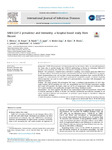2021-01-17Zeitschriftenartikel
SARS-CoV-2 prevalence and immunity: a hospital-based study from Malawi
Meinus, C.
Singer, R.
Nandi, B.
Jagot, O.
Becker-Ziaja, B.
Karo, B.
Mvula, B.
Jansen, A.
Baumann, J.
Schultz, A.
Background:
COVID-19 transmission and disease dynamics in sub-Saharan Africa are not well understood. Our study aims to provide insight into COVID-19 epidemiology in Malawi by estimating SARS-CoV-2 prevalence and immunity after SARS-CoV-2 infection in a hospital-based setting.
Methods:
We conducted a hospital-based, convenience sampling, cross-sectional survey for SARS-CoV-2 in Lilongwe, Malawi. Participants answered a questionnaire and were tested for SARS-CoV-2 by enzyme-linked immunosorbent assay and real-time reverse-transcription polymerase chain reaction (RT-PCR). A surrogate virus neutralization test (sVNT) was performed in seropositive samples to estimate immunity. Poisson regression was used to assess SARS-CoV-2 point prevalence association with demographic and behavioral variables.
Findings:
The study included 930 participants. We found a combined point prevalence of 10.1%. Separately analyzed, RT-PCR positivity was 2.0%, and seropositivity was 9.3%. Of tested seropositive samples, 90.1% were sVNT positive. We found a high rate (45.7%) of asymptomatic SARS-CoV-2 infection. SARS-CoV-2 point prevalence was significantly associated with being a healthcare worker.
Interpretation:
Our study suggests that official data underestimate COVID-19 transmission. Using sVNTs to estimate immunity in Malawi is feasible and revealed considerable post-infection immunity in our cohort. Subclinical infection and transmission are probably a game-changer in surveillance, mitigation and vaccination strategies.
Files in this item

